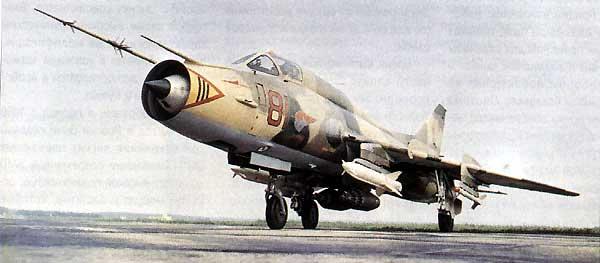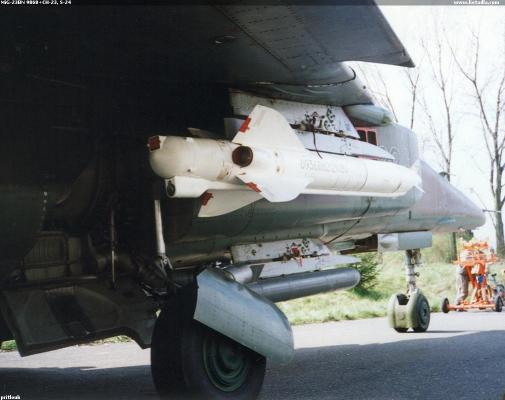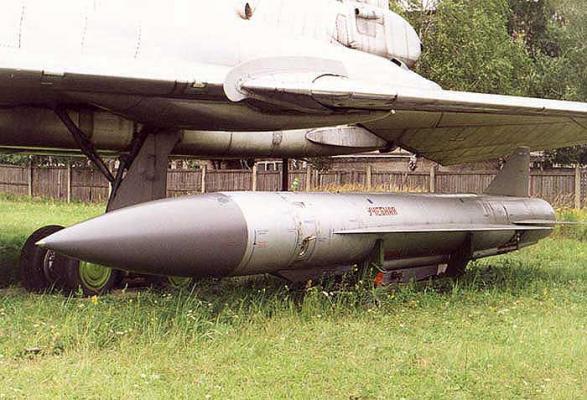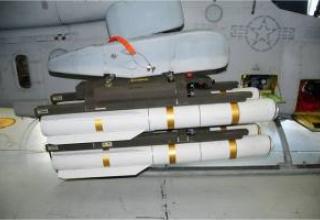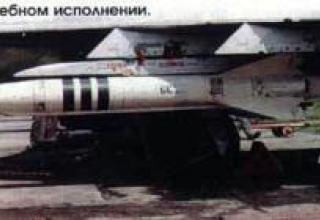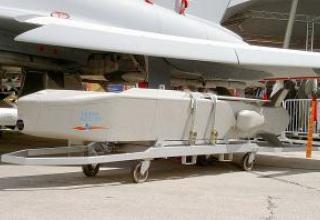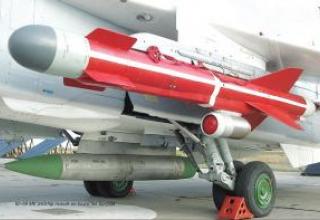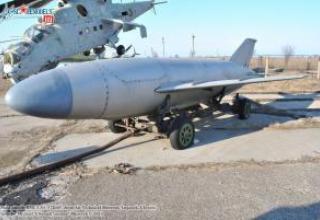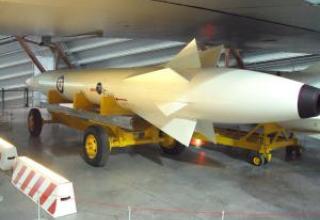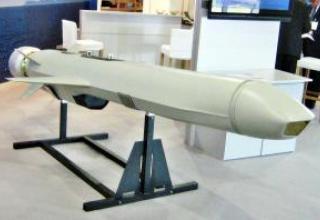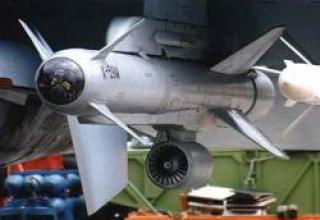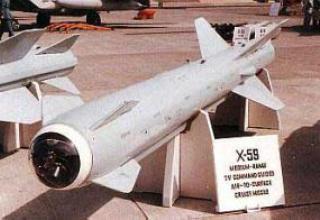In 1973, the X-23 tactical missile was adopted for service with the fighter aircraft. The missile was designed to engage ground small targets and small ships.
Development of the X-23 missile (item 68, "Thunder") began in April 1965 at the Design Bureau "Vympel", later in 1968 was continued at the Design Bureau "Zvezda". (Chief Designer Khokhlov G.I.).
X-23 missile was created on the basis of X-66 missile with a new hardware complex. The main difference of the X-23 was the installation in the tail compartment of the equipment for receiving and decoding of coded control radio signals. Factory tests were conducted from early 1968 to late 1969. Due to the unpreparedness of the radar "Sapphire-23" for operation, the first versions of the MiG-23S were equipped with the radar "Sapphire-21" (RP-22SM) and optical sight ASP-PDF-21, created for the MiG-21, so that the MiG-23S could not use missiles X-23, R-23R and R-23T. Later models of MiG-23 aircraft used X-23 missiles. State testing of the missile was conducted from MiG-23 and MiG-23B aircraft until the fall of 1973. The following year, the X-23 was adopted a pair of weapons. It was used on frontline aircraft using the integrated command system "Delta-N" and "Delta-NM" (on MiG-23, MiG-27, MiG-23UB and Su-24), as well as an overhead containerized aircraft - "Delta-NG" (on Su-17, MiG-23M, ML, and MiG-27K/M).
In the late 1970s, a variant of the Mi-14PL anti-submarine helicopter with a guided missile system with two X-23 missiles was created at the request of the Syrian Government and was flight and fire tested in 1983. Tests were conducted on the Kh-23 (Kh-23M) and Ka-25 and Ka-252 helicopters.
The combat experience of the Kh-Kh-23 in Afghanistan has revealed serious shortcomings of this product, primarily due to the use of the radio command guidance system. After the missile was launched, the pilot had to simultaneously combine the center mark of the sight with the images of the missile and the target, monitor the situation, maneuver, evade enemy aircraft and anti-aircraft fire. On the basis of the X-23 missile created a modified version of the X-23M, equipped with an advanced control system.
Later in the domestic air force, Kh-Kh-23 and Kh-Kh-23M missiles were replaced by X-25MR missiles.
In the west, X-23 and its modifications were designated AS-7 "Kerry".
Composition:
The X-23 missile had an aerodynamic "duck" pattern (see projections, layout diagram).
Radio command visual guidance along the tracer by the "three points" method. The tracker is mounted on a bracket under the missile's tail part. Time of remote control 27 sec. To point the missiles X-23 used airborne guidance equipment "Delta-N", "Delta-NM". It is possible to use an overhead container with guidance equipment - "Delta-NG". The MiG-23UB combat trainer aircraft used the Delta-NM equipment built into the right wing fixed part to point the X-23 missiles. During pointing, the pilot, following the route of the missile, corrected its deviation from the target by moving up and down and left-right specially movable button - dummy on the control knob. The tests revealed the unreliability of guidance - the cause was the influence of the track mounted near the receiving antenna of the on-board guidance system "Delta-P1M". Rupor antenna and its waveguides were heated and vibrated. Removing flaws, the tracker was replaced and placed under the missile body on a bracket.
Semi-automatic guidance of the X-23 was carried out with the help of a teplenelengator, tracking the flight of the rocket along its route. In this case, the pilot was required only to hold the target in the crosshairs of the sight, and the equipment determined the deviations of the missile from the line of sight and formed control commands. This method was used in the Arkan guidance system on the Su-24, which used a television direction finder for the Taran-R missiles, which automatically determined the X-23 angular coordinates and issued them to the radio command line.
The launch of the X-23 was possible from a dive and a horizontal flight, but after it the pilot was still tied up in maneuver - the missile had to be kept in sight and the barrel to get to the target. For this reason, the launch range of X-23 did not exceed 3-10 km (depending on altitude), and the effectiveness of the attack reduced and purely psychological factor - when confronted with the air defense fire, the pilot stopped tracking the target and all the attention was paid to anti-aircraft maneuvering. Partly these shortcomings were eliminated in the upgraded version of the X-23M (product 68M), equipped with a more advanced radio control system and a track of increased aperture T-60-9 (instead of T-60-5), which facilitated visual support. The aerodynamics of the rocket and the shape of the plumage were slightly modified. The new Delta-P2M onboard equipment made it possible to extend the radio receiver control yoke, making it easier to point the missile.
The missile is launched from a fighter-bomber flying at speeds of 550 to 1500 km/h at altitudes of 100 to 5000 m. The launch angle in relation to the target is from 2 to 40°. The X-23 was suspended on the airborne launchers ACU-68U (UM).
The engine is solid fuel with a total thrust pulse of 110000 n/s.
The combat unit of the rocket is cumulatively shatterproof and equipped with a powerful explosive of TG-40 type. In two side segments of the combat unit there are 1,488 ready-made attack elements - steel cubes with 10 mm rib, which were blown sideways and forward. The BC provided a continuous engagement of unarmed targets within a radius of up to 40 m and the destruction of protected objects with a thickness of armour up to 250 mm. The BC was equipped with a non-contact ROV-19L fuse, which ensured detonation when flying over the target, and in case of a direct hit contact sensors SKD-24 located in the steering compartment were triggered.
The TNR-23 ground simulator was designed to train pilots to work with the X-23 missile.
Characteristics:
| Airplane carrier | MiG-23, MiG-23B, MiG-23BC, MiG-23UB, MiG-27M, Su-24M, Su-17M1, Su-17M2, Su-17M3, Su-22M1, Yak-38 |
| Length, mm | 3591 (3630) |
| Maximum fuselage diameter, mm | 275 |
| Wingspan, mm | 785 |
| Wheelspan, mm | 424 |
| Missile launch weight, kg | 289 |
| Weight of the rocket at the end of the boost phase, kg | 225 |
| Weight of combat unit, kg | 111 |
| Range of sighting, km. | 2-10 |
| Flight Speed, m/s | 750 |
| Height of application, m | 100-5000 |
| Circular probable deviation, m. | 6 |
| Hit probability | 0.56-0.62 |
Testing:
The X-22 missile proved to be a very effective anti-ship vehicle even without a nuclear charge. Tests have shown that in the event of a sea target being hit, the X-22 would cause damage to the target ship, which could disable an aircraft carrier or cruiser. At the take-off speed of 800 m/s, the area of the hole was up to 22 sq.m., and the inner compartments were burned by a cumulative jet to a depth of 12m.
The Soviet leadership considered the aircraft Tu-95K-22 and Tu-22M3 with the X-22 rocket the most effective tool to combat aircraft carriers. Therefore, Soviet heavy aircraft systematically approached the U.S. aircraft carriers and recorded the action of radio electronic interference Americans. According to navigators, the effectiveness of these tools was tremendous: the target markings on the screens literally drowned in a cloud of interference, it became impossible to aim. Therefore, a version of the attack was developed, according to which the first to launch X-22 missiles with nuclear warheads are not on specific targets, and the area where the American aircraft carrier connection was to be. It was believed that after that the action of electronic countermeasures will significantly reduce, and the second wave of X-22 missiles will find surviving targets.
Measures to overcome the air defense included a variety of tactical techniques: massaging efforts of several strike groups, echelonizing the combat orders of missile carriers and air defense aircraft that covered them, maneuvering during an attack. The strike could be delivered by reshaping several units and launching from different directions, frontal attack with salvo launch of dozens of missiles, consecutive disabling of cover ships, weakening of the air defense and defeating the main target. Sometimes a distraction group of aircraft stood out. During combat training, the targets were real AUGs, which were within the reach of missile-borne units. The appearance of potential enemy ship groups near the Soviet shores usually served as an excuse to work out a plan of counteraction with training anxiety and regimental flight. During daily training, crews were limited to tactical launches.
Until the beginning of the 90s, the crews of both YES and Navy conducted combat firing at sea targets in the Caspian Sea, for which the crews from remote airfields moved closer to the firing range during training sessions. Mozdok usually served as a base for "long-range" airfields, and Oktyabrskoye in Crimea served as a base for "sailors". Over time, the range in the Caspian Sea, which had been in operation since the 50s, was closed by environmentalists' demands due to the contamination of the sea with countless missile debris. Problems have also arisen with the organization of shooting at the Akhtuba range, which is now under Kazakhstan's control.
With the removal of weapons Tu-22K and Tu-95K-22 missile system K-22M continued to remain in service, using the aircraft Tu-22M3 - the most modern machines of this type. Equipped with these parts are the basis of the missile forces of the YES and the Navy in Russia and the Ukraine. By 1994, there were 92 aircraft of this type in Ukraine and the Crimea.
In April 1987, the forces of the Russian YES were consolidated into the 37th FA of the Navy. To date, the Tu-22M3 are in service with four of its air regiments, as well as two maritime missile-bearing regiments on the SF and TOF (in the early 80's at the height of Soviet aviation fleet had a fleet of one and a half dozen missile-carrying regiments).
After several years of uncertainty, rocket firing at newly equipped firing ranges also resumed (their arrangement was linked not only to the choice of small, extensive locations for safety requirements in case of missiles or irregular missile behavior, which sometimes happened, but also to the equipment of measuring posts and telemetry control points). For the first time, the Tu-22M3 of the Severomorsk Kirkenes Red Banner Air Division carried out missile launches in the Barents Sea during the Zapad-99 command and staff exercise in northern Russia. Striking together with the missile ships of the fleet, 24-26 June 1999 TU-22M3 "destroyed" detachment cover enemy ships at a range of 100 km, and the "main target" - with 300 km. In September the same year, the TU-22M3 detachment conducted missile firing at targets four X-22.
During a joint exercise of the Air Force of Russia and Ukraine August 11, 2000 a pair of Poltava Tu-22M3 made a five-hour flight to the North and together with 10 Russian aircraft attacked targets at the testing ground near Novaya Zemlya. Although only three pilots had participated in the launches before due to the long break, both target barges were hit.
Two weeks later, on 25th August 2000, the crew of the Ukrainian Tu-22M3 performed an unusual task: providing joint exercises of the Air Forces and Air Defence at the Arkhalyk range, after a long flight it fired an X-22 target missile successfully intercepted and hit by Su-27 fighters.
On 6 April 2001, during a major exercise of the 37th Air Force combined with the Yuzhny Shield-2001 KShU, the X-22 was launched, which was of research nature: a missile that had been stored in a warehouse for 25 years was taken to check reliability. Launch from the board of the Tu-22M3 at the Makat test site was a success, all systems of the X-22 worked off routinely. Less successful were the shooting at the new range near Chita in September 2002 - due to failure in the guidance missile fell in Mongolia, causing a scandal and demands for millions of compensation (the same slippage took place in Kazakhstan, where the X-22 fell near the village).
The X-22 took an exceptional place in domestic aviation and rocket technology - both in terms of the service life of the complex, approaching the 40-year mark, and the universality of application. Unlike other missiles of its class, whose service was limited to a single type of aircraft (in turn, a special modification of which was created for a certain complex of missile weapons). X-22 was armed with three carrier aircraft - Tu-22K, Tu-22M and Tu-95K-22.
However, the long service and improvement of the complex could not save it from a significant disadvantage - low serviceability associated with the use of liquid rockets. The high performance achieved by the use of liquid-propellant missiles, brought with it organic flaws and problems with ensuring the combat readiness of missiles, which required equipment with toxic and caustic components - acid and no less harmful fuel.
Prolonged storage in refueled form proved to be unacceptable due to corrosion resistance of the structure. The use of protective coatings and inhibitors - corrosion retardants - also prevented this threat from being radically eliminated. At one time, the solution was to organize a continuous cycle of work on missiles, in which at the expiration of the period of maintenance of fuel and oxidizer refueled AKR from them, removed BC, the tanks were washed with neutralizing solution, dried, and the missiles were put in storage, while the next stage of the AKR after the equipment was ready for combat duty. The labor-intensiveness of such a "carousel" with maintenance of constant combat readiness created too many obstacles; and the main direction was to improve the refueling technology, which accelerated the process as much as possible and simplified it with due security.
The most effective measure was the introduction of ampoule filling with a special unit. The oxidizer from its sealed pressure vessels was pumped into the rocket tanks, remaining virtually isolated from the environment. Filling was carried out just before firing, and storage of the missiles was no longer permitted. The equipment of the rocket technicians included a protective special suit with a woolen suit to be worn under it, thick rubber gloves on top of ordinary knitted ones, and bashila boots in a thick finger. The equipment was equipped with an insulating gas mask, and the filling process was controlled by a gas analyzer in case of leakage. Labor-intensive operations in combat units were avoided as much as possible, and flights with unpacked missiles became a common practice even at the exercises. In full, their training was carried out only when offsets launches were carried out, at best, during training sessions 1-2 times a year. Shooting was an event, and in practice, given the responsibility, only the most trained crews with similar experience were allowed to fly. The training usually took at least one month, with several rehearsals. The launch always took a couple in which a substitute crew provided backup in case of refusal. Sometimes volley launches were made by a pair of missiles or both crews, including X-22 of different types with radar and inertial guidance.
Sources:
- А.В.Карпенко, С.М.Ганин "Отечественные авиационные тактические ракеты" - СПб,"Бастион", 1.2000
- Н. Сойко, Н. Якубович "Русские молнии под индексом Х", "Техника-Молодежи" N2 1993 г.
- Широкорад А.Б. "История авиационного вооружения", -Мн.: Харвест, 1999.-560с.
